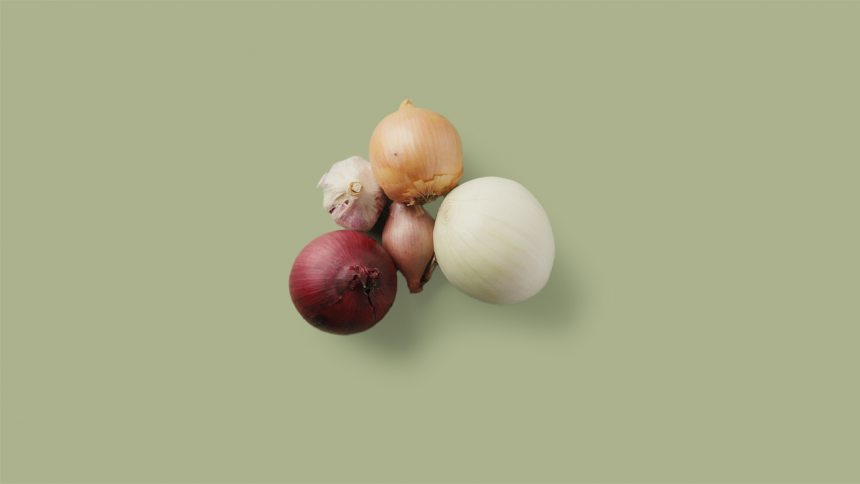
The smell of onions gently cooking on the stove or barbecue is enough to start you salivating, even if the act of peeling them might make you shed a few tears. The latter is due to the onion’s sulphuric content, though it affects some people more than others.
Onions belong to the same allium family as leeks and garlic and can leave you with the same whiffy breath as the latter, particularly eaten raw. But don’t let that put you off this wonderful vegetable – just chew a piece or two of parsley to restore that fresh feeling.
Onions have been around for a very long time
- Onions date back to the Bronze Age, with the oldest known harvest about 7000 years ago. Their exact origin is not known, with records showing their use across West and Central Asia, including Iran and Pakistan.
- The spring onion was domesticated in China about 6000BC, while recipes featuring onions and others in the allium family popped up on Mesopotamian clay tablets dated from 2000BC.
- Onions were worshipped by Ancient Egyptians, who believed their shape and rings represented eternity and used them in burial rituals.
- Romans believed the onion could improve eyesight, sleep and heal everything from sores to dysentery.
- Farmers often used the onion to predict the coming season. One of the oldest uses of the ‘onion oracle’ is in Urbania, Italy, where the onion’s layers are peeled, separated into 12 pieces and topped with salt to determine how wet or dry the coming months will be.
- New York City was known as the Big Onion before it became the Big Apple, because of its many layers.
Onions have different strengths
- Brown onions, sometimes called yellow onions, are the most common variety in Australia. Only their outer skin is brown; peel off the casing to reveal a creamy flesh that can be sliced and diced for almost any dish. As they are the more pungent of onions, however, they tend to be cooked rather than eaten raw, such as these decadent onion fritters.
- White onions have a white skin and a milder flavour than the brown, which is why you’ll often see them listed in ingredients for salads.
- Red onions have a papery purple skin and a purple-red flesh. Also called Spanish onions, they are great raw, cooked or pickled. They also pair beautifully with goat’s cheese in this terrific tart.
- Also known as green onions or scallions, spring onions are very young onions that have been picked before their bulbs swell up. They look and taste great in stirfries, soups and salads, as well as a simple topping for delicate dishes such as these half-shell scallops.
- Pickling onions are much smaller onions that have a thin protective layer. They can be white or brown and are mainly used for pickling.
- Shallots, or eschalots, are related to both onion and garlic, but aren’t either. Chefs often use these smaller, oval-shaped bulbs instead of onions because of their sweeter and milder flavour.
Onions are good for you
- Onions are about 89 percent water, with about 9 percent carbohydrates and fibre, and a tiny amount of protein and fat.
- They are among the only dietary source of healthy soluble fibres known as fructans, which feed beneficial bacteria in your gut, helping to improve colon health and reduce inflammation. (Fructans can also cause digestive issues for people with conditions such as irritable bowel syndrome.)
- They also contain vitamin C and B6, which helps form red blood cells, and folate, which is particularly important for mothers-to-be.
- Potassium is another of their health-giving properties. This essential mineral can help reduce blood pressure and improve heart health.
- They can also help combat Type 2 diabetes, by lowering blood sugar, and prevent the bone deterioration that leads to osteoporosis.
- Red and yellow onions are richer sources of antioxidants, such as flavanoids associated with improved heat health and sulphur compounds that are believed to protect against cancer.
- Cooking onions can reduce the levels of some antioxidants, so get some raw onion in your diet.
They aren’t hard to grow
With local growers such as Patane Produce and Glavocich Produce keeping us well-stocked year round, there is certainly no need to grow your own onions. But if you fancy some homegrown bulbs, they aren’t too hard to propagate. You just have to be patient.
- Onions can be grown from seed or seedling. They like a mild summer and winter, though this varies according to the type of onion.
- They need fertile, well-drained soil so they don’t rot. Sandy loams are recommended for their lower sulphur content. Prepare with aged sheep or cow manure.
- Sow the seeds in autumn or winter, depending on where you are based, and plant them in a sunny spot 5cm deep in the soil about 30cm apart.
- You can harvest about six to eight months after planting. The leafy tops weaken, go yellow and fall off as the bulbs fatten, ready for picking.
- Spring onions will be ready much sooner – harvest as soon as they are big enough.
- Store onions in a dry, dark place and they will keep for a few months.
- Ask your garden centre for advice before getting too carried away.
And if you need ideas to use up those onions, see our recipes page.